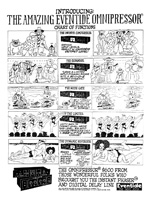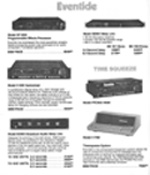Eventide Repair and Service
Shipping your Eventide to us for servicing
We love Eventide and their gear, though we’ve stopped servicing some of the early models. Here’s a partial history of that landmark company, with typical costs for the models that we service.

Eventide Clockworks PS-101 Instant Phaser
 Eventide FL201 Instant Flanger
Eventide FL201 Instant FlangerService costs for the Instant Phaser, Instant Flanger, and Omnipressor can vary. Faulty switch assemblies can add expense, and Omnipressors often have faulty meters, which increases repair cost. (The switches are an unusual type that are no longer made, but we have a good stock of new and used replacements.) We stock all the parts for these units, including the Reticon CCD chips in the Flanger and the dbx modules in the Omnipressor. These are valuable units, well worth the cost of servicing. Please note that all declined Eventide repairs are subject to a testing and evaluation fee.
There were other late 70’s products. The Monstermat was not so successful scheme to improve the sound quality of radio station cart machines. Better received was the BD955 broadcast obscenity delay, which allowed the producer or engineer of a talk show to mute the words telephone callers without interrupting the program. The first version used 160 RAM chips!
 Eventide H910 Harmonizer
Eventide H910 HarmonizerAgain, the H910 was the first true studio pitch changer. Eventide’s de-glitch circuit was still a few years away, but you got dual outputs, each with short, selectable delay times. The dbx type II noise reduction cards on the input and outputs allowed a whole 90 db of dynamic range. Though we no longer service the H910, we stock many of its original parts.

I believe that the Eventide H949 Harmonizer hit the market in 1980. Its many improvements over the H910 included “micro” pitch change mode, two pitch change algorithms (neither sounded perfect, but at least the user had a choice), a basic flange function, up to .393 seconds of delay, and “Reverse” mode, which played a stored sample backwards.
Units with serial numbers above 1606 could be fitted with the optional “Lupine” LU618, the world’s first degitch circuit for pitch change. (Early pitch change circuits “spliced” the waveform, with additional splices at extended pitch change settings. This electronic splicing produced periodic clicks. The algorithm on the Lupine card (whose name came from a Monty Python sketch) selected splice points at equal voltage levels, greatly reducing pitch change artifacts.) An H949 with a deglitch card will be marked “option: ALG-3” on its serial number badge.
Another interesting Harmonizer option was the HK940, a two octave keyboard for external control of the H910 and H949. Few of these units survive — if you own one, you’re quite fortunate! For a cool trip down memory lane, check out this original H949 sales brochure. As with the H910, dbx type II cards were used to increase dynamic range. We no longer service H949’s, but stock many hard to find parts.
As with the H910, dbx type II cards were used to increase dynamic range. Like the H910, we no longer service H949’s, but stock many hard to find parts.

Eventide H3000
This brings us to the famous Eventide H3000 and H3500. These are true industry standards, seen in all world class studios. Their hundreds of effects algorithms and 600+ available presets provide a wide variety of effects including true stereo pitch shift, pitch-correcting diatonic pitch shift, linear-predictive vocoder, six voice polyphonic synth, and a 19 waveform LFO function generator with full control. The multi-shift algorithm allows six octave pitch shift. Other programs include ultra-tap delay, instant phaser, swept comb filter, and multi-band delay. The LFO offers 19 periodic or triggered waveforms, with pink and white noise assignable to most effects parameters. The D/FX added new algorithms and presets, including a range of Stevie Vai settings. Both models have comprehensive MIDI implementation.
We service all versions of the H3000 and H3500 and can update the program chip sets. Typical service cost is $820.00. This is a labor intensive servicing that includes power supply recap, cleaning any intermittent soft key switches, power supply connector replacement and upgrade, replacement of the NVRAM battery backup IC, cleaning the inside window of the alphanumeric display, internal adjustment of display brightness (if needed), other minor repairs that may be needed, and calibration of the offset and distortion trims. Upon completion, we do a complete 108 point check out of the analog and digital sections using Eventide’s proprietary H3000 test software, replace any missing or damaged chassis screws, and use a paint pen to touch up scratches in the black areas. For users in areas outside of North America, we have a small quantity of alternate version power transformers that are optimized for 50 Hz. power.
Note: in recent years many H3000’s have come to us with dead power supplies, sometimes with customer comments about smoke from the motherboard and burning smells. These problems are nearly always caused by shorted capacitors, which can cause additional failures in the power supply circuits. In these cases repair and testing can be very time consuming because the motherboards have dozens of capacitors in parallel, there’s no easy way of individually testing them, and often many (or most) need to be replaced. These problems can always be repaired, but additional cost is often $200-$250.

 Omnipressor Chart of Functions
Omnipressor Chart of Functions 